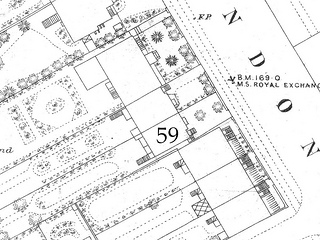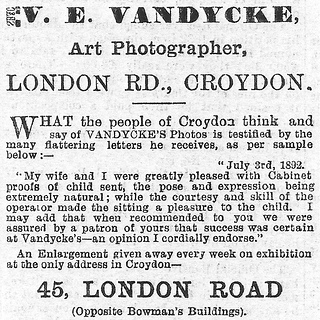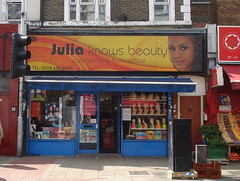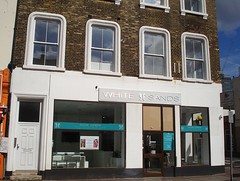59 London Road is currently home to a butchers, grocers, and greengrocers known as Croydon Food Centre. This is a relatively new addition to London Road, having opened in 2011. By October of that year it was trading from numbers 59–61, but it later retrenched to number 59 alone.
1840s: Construction of the building
In contrast to its current occupant, the building itself is one of the oldest on this part of London Road. It was constructed along with its neighbours at numbers 61–65, some time between 1844 and 1851, in what was then a large empty space between the Fox & Hounds pub and a pair of houses (later demolished) further up the road on the plot now occupied by numbers 79–87. Numbers 31–57 followed a few years later, but the full complement from number 1 upwards wasn’t completed until the early 1880s.[1]
1850s–1860s: George Radcliffe, Henry Thomas Dwight, and Joseph Foster Holmes
Like most of the buildings along London Road before the late 1850s, number 59 started its life as a private residence. The first resident who appears in the documentary record is George Radcliffe (or possibly Rattcliff), a fish salesman who worked in the City of London and lived on London Road with his wife Mary and two servants.[2] Perhaps he chose to live here in order to be close to the railway station — one of Croydon’s first commuters!
George and Mary Radcliffe had departed by 1855, and by 1858 the house was occupied by Henry Thomas Dwight. By the time of the 1861 census, Henry in turn had been replaced by Joseph Foster Holmes. Although Gray and Warren’s 1861–62 directory lists him as a “gentleman”, the census reveals that Joseph was in fact a banker’s clerk.[3]
early 1870s: Henry Wells Buer
By 1871, the beginnings of commerce had arrived at 59 London Road in the person of Henry Wells Buer, who was involved in some way in the money-lending trade. However, it’s not clear whether he had an actual shopfront business here, or whether he simply supplemented his day job with financial activities conducted from home.[4]
It’s also not clear that his money-lending activites were particularly legitimate. He, or at least someone using his name and address, placed several advertisements in a Yorkshire newspaper in 1873, offering 5-year unsecured loans at only 5% interest.[5] The distance of Yorkshire from Croydon, the overly-long term for an unsecured loan, and the suspiciously generous rate of interest all suggest some form of advance-fee fraud. Indeed, in December 1879, two men named John Airey and William Kelly were sentenced at the Old Bailey to nine months imprisonment each for conducting this type of fraud using Henry Buer’s name. Henry himself was not tried, possibly because he’d got out of the business by then.[6]


late 1870s: Charles Manser, draper
Whether Henry Buer was honest or not, he only remained on London Road a couple of years. Commercial activities continued after his departure in the form of Charles Manser’s drapery business, in place by 1876.[7] By 1881, however, there was at least partial separation between the commercial and residential activities at the premises. The 1881 census lists a “Shop” with its own address in between numbers 57 and 59, and Joseph and Fanny Hansmann in residence at number 59. Joseph and Fanny were also involved in the garment business, and so could perhaps have had some business connection to Charles Manser. However, their own shop was diagonally across the road at number 38.[8]
1880s: Extension and division
It’s likely that this split of number 59 into two addresses took place at the same time as the ground floor was extended forward over what had previously been the front garden of the premises. Historical maps make it clear that the extension was built between 1868 and 1896, and probably after 1880.[9] In addition, although the fronts of 59 and 61 are level today, 59 was extended before 61 was.
Another interesting aspect of the extension is made clear in a planning application from 2011 (ref 11/02274/P), which includes a diagram showing a side view of the building (PDF; see top right-hand corner) — the shop as it is today extends back into the original building, but the floor is substantially lower than the level of the original ground floor. Referring back to the 1868 Town Plans excerpt, it seems clear that the house was originally built with steps up from the front garden to the ground floor; the extension, being built on the front garden itself, would therefore have been lower down.
1880s: Tea, clothing, fancy goods, and oysters
Although the 1881 census suggests that the split into two properties created one residential address and one commercial one, the 1880s saw Croydon’s businesses take full advantage of both. John Littlebury’s Assam Tea Company was in place by the beginning of 1882, and was joined shortly afterwards by a pair of dressmakers, Miss Thurgood and Miss Bangs.
By 1884, Thurgood & Bangs had become M H & S E Thurgood’s “Berlin Wool, Stationery, and Fancy Repository”; and by 1885, John Littlebury had given way to Brown & Son, hosiers and shirtmakers. Brown & Son was to remain in place until around 1888, but its neighbours were more volatile. By 1886, the Thurgoods had passed their fancy repository on to a Mrs Bishop, and by 1887 the fancy goods were gone and in their place was P R Schröder’s oyster bar. The oyster bar itself was short-lived, and gone by 1888.[10]

1890s–1910s: V E Vandycke, photographer

The churn of businesses finally settled down around 1888, with the arrival of V E Vandycke, photographer. Initially sharing the premises with Brown & Son, by 1889 V E Vandycke was the sole commercial occupier.
The documentary record around V E Vandycke poses something of a puzzle. Ward’s directories list V E Vandycke, photographer, at the premises from 1888 to 1906 inclusive and from 1910 to 1913 inclusive, but there’s a period from 1907 to 1909 when they instead list M Lepard, photographic studio. Moreover, the 1891, 1901, and 1911 censuses don’t show anyone with the surname “Vandycke” living in Croydon.[12]
The 1911 census for this address shows Thomas Henry Billinghurst, photographer, working “At home” on his “Own account”. However, a newspaper report from 1912 implies that V E Vandycke lived alone in the premises. This report, published in the Dundee Courier of 18 September 1912[13] describes a fire “in London Road, Croydon, at premises occupied by Mr Vandyke [sic], a photographer.” The report goes on to explain that “Mr Vandyke and a friend awoke to find the place full of smoke, and they escaped by dropping 15 feet into the garden. [...] The fire is supposed to have originated in the dark room, and the damage is estimated at about £1000.”
Four people in a neighbouring house were also forced to escape the premises,[14] and the report explicitly states that “Six persons were in danger”, so it seems unlikely that anyone other than “Mr Vandyke” and his friend were in number 59. The neighbours are described as having escaped “in their night clothing”, so the fire clearly took place at night.
It’s possible that the reporter simply assumed that the owner of number 59 had the same name as the business conducted there, but according to the census Thomas’s family in 1911 included a wife and three teenaged/adult children, so it seems unlikely that in 1912 he would have been living in the premises without them. It thus remains unclear whether there was ever an actual person named V E Vandycke living or working on London Road!
1910s–1920s: Tailors and dentists
Whoever V E Vandycke was (or wasn’t), by 1914 he no longer had a presence on London Road. Number 59 saw quite a turnover of occupiers during the following decade, including Lumm & Co, tailors; J E Little, ladies’ and children’s outfitter; and a succession of dentists. It’s possible that at least some of the dentists were on an upper floor of the building, as street directories suggest that they shared the premises with J E Little.[15]
1920s–1930s: J & M Stone, lighting specialists; F W Fuller, dentist
The most long-lasting of these dentists was F W Fuller, who arrived at the premises around 1924 and remained until around 1937 before moving across the road to the first floor of number 28.[16] F W Fuller shared the building with J & M Stone (later J & F Stone), lighting specialists, who were in place by 1925 and remained until at least 1939.[17] It seems likely that J & M Stone was on the ground floor and F W Fuller was on an upper floor; a late-1940s photograph in the Croydon Local Studies collection shows J & F Stone branding across the entire shopfront.[18]
1950s–1970s: Fyne Fireplaces Ltd; House of Ceramics
By 1950, 59 London Road was home to Fyne Fireplaces Ltd, a manufacturing business that also had premises in Purley and later in Beddington. This remained until the mid-1970s, when it was replaced by a ceramics shop. There's little documentation of the name of this shop, though by 1980 it was known as House of Ceramics.[19]
1980s: Afrodite hair salon; The Vineyard wine bar
By 1983 the premises were occupied by Afrodite hairdressers, and by late 1984 plans were afoot to expand the business into a wine bar. Planning records show that the intention was to use the ground floor as a wine bar called Afrodite Wine Bar, with the salon occupying space on the first floor. However, it isn’t clear whether the salon began life on the ground floor and moved to make way for the wine bar, or whether the salon was always on the first floor and the ground floor spent some time vacant.[20] In either case, by late 1985 the name of the proposed wine bar had changed to The Vineyard,[21] and phone books suggest that it was open by 1987.[22]
1990s: Barracuda fish bar
By early 1990, however, The Vineyard had been replaced by Barracuda fish bar. It’s unclear whether this was a restaurant or simply a fish and chip shop; Goad plans describe it as a “fried fish shop”, while phone books list it as a “fish & seafood restaurant”. It remained until around 1999. By May 2000 it had been replaced by a bakery/patisserie called Jown, though this only lasted around a year.[23]
2000s: Halal Meat Centre
In April 2001, Dr Mardan Ali Mahmood took on an 11-year lease for 59 London Road,[24] and by June of that year the premises were home to the Halal Meat Centre. This remained in place until 2011.[25]
2011–present: Croydon Food Centre
Two events occurred during 2011, and it’s not clear what order they happened in. One was the extension of the shop into the then-vacant number 61, and the other was the replacement of the Halal Meat Centre with the Croydon Food Centre.[26] However, whether the extension happened before or after the change of management, by March 2012 it had been reversed.[27]
Today, the Croydon Food Centre trades from number 59 alone. A butcher’s counter runs along one wall, offering lamb, chicken, offal, and other meat products. On the other side of a narrow aisle, shelves hold African and Caribbean groceries including pounded yam flour, gari, dried beans, sauces, relishes, and spices. Fresh vegetables are on display along the pavement at the front, adding to the colourful appearance of London Road.
Thanks to: Brian Gittings; Bill Shears; Blom ASA; the Planning Technical Support Team at Croydon Council; all at the Croydon Local Studies Library; and my beta-readers Henry and Kat. Census data and London phone books consulted via Ancestry.co.uk.
Footnotes and references
- See my article on 31 London Road for more discussion of the initial development of this part of London Road. A similar picture was seen on the other (east) side of the road; I’ll be discussing this in a future article.
- Gray’s 1851 Directory of Croydon lists George Radcliffe [sic], “fish salesman in the City”. The 1851 census lists him as George Rattcliff, age 60, fish salesman, born in Bermondsey. His wife Mary, age 58, born in Margate, is also listed, as are two servants, 18-year-old Ann Selwood and 23-year-old Emily Curling (or possibly Carling).
- Gray and Warren’s 1855 directory lists the property as unoccupied. The October 1858 Poor Rate Book lists Henry Ths [Thomas] Dwight, and Gray and Warren’s 1859 directory lists Henry Thomas Dwight, “private resident”. The 1861 census shows Joseph Foster Holmes, bankers clerk, age 42, along with his 43-year-old wife Elizabeth, their daughters Catherine (12), Edith (11), and Florence (8), and their 22-year-old servant Sophia Walker. Joseph is also listed in Grey and Warren’s 1861–62 directory (as a “gentleman”), the Poor Rate Books from November 1862 to October 1866 inclusive (at least), Simpson’s 1864 directory, Warren’s 1865–66 directory, and Warren’s 1869 directory.
Henry Buer appears in the 1871 census, with profession given as one unreadable word (possibly “Scrivener”) followed by “Money lender” in brackets. Wilkins’ 1872–3 directory has H W Buer, loan office; the December 1873 Poor Rate Book has Hy [Henry] [some initial or other] Buer; and Ward’s 1874 directory has Henry W Buer (with no profession given, which in these directories usually indicates a private residence). Regarding his profession in the 1871 census, Henry Braun points out that “a ‘scrivener’ can mean either a money-lender or a lowly sort of copying clerk” (online conversation, 22 October 2014).
- A search in the British Newspaper Archive reveals that Henry Buer’s advertisements appeared in the Yorkshire Post and Leeds Intelligencer between January and June 1873 at least. He also placed similar adverts in other local papers including the Huddersfield Daily Chronicle, the Ipswich Journal and Suffolk, Norfolk, Essex, and Cambridgeshire Advertiser and the Bucks Herald — Uxbridge Advertiser — Windsor and Eton Journal. See the newspaper advertisement in the main text for the full wording.
- Thanks to Henry Braun for suggesting and investigating the possibility of advance-free fraud. A letter on page 6 of the 20 January 1870 Glasgow Herald describes how this type of fraud would have worked. See Proceedings of the Old Bailey, reference t18791215-117 for details of the trial of John Airey and William Kelly.
- Charles Manser, draper, is listed in Ward's 1876 directory, Wilkins’ 1876–7 directory (as C Manser), Ward’s 1878 directory, Worth’s 1878 directory (as C Manser), Atwood’s 1878 directory, and Ward’s 1880 directory.
The 1881 census shows Albert Sanders and family at 22 London Road (later renumbered to 43 and then to 57), then “Shop” at 23a, then Joseph and Fanny Hausmann [sic] at 23 London Road (later renumbered to 45 and then 59). As well as the numbering (which can be misleading), the reason I think the “Shop” was part of 23 rather than 22 is that Albert Sanders ran a business on his premises (see my article on number 57) and hence the ground floor of his house would likely have been occupied by that.
Note that, as explained in my article on number 38, although the census had Joseph and Fanny’s surname as “Hausmann”, I believe this to have been a mistake caused by the census transcriber misunderstanding Joseph’s handwriting; their surname was actually “Hansmann”.
- The 1880 Ordnance Survey map shows what are probably a couple of trees in a rectangle where number 59’s front garden would have been, suggesting that the extension hadn’t been built yet.
- The addresses shown in contemporary street directories are 23 London Road and 23a London Road. Number 23a disappears from the documentary record around 1889. Number 23 was renumbered to 45 in 1890 and again to 59 in 1927. The split in the late 1880s appears to have had John Littlebury followed by Brown & Son at one address, and all the other occupants in sequence at another. For number 23, John Littlebury is listed in Purnell’s 1882 directory (as John Littlebury, tea dealer) and Ward’s 1882 and 1884 directories (as J Littlebury, Assam Tea Company). Brown & Son is listed at the same address in Ward’s directories between 1885 and 1888 inclusive (first as Brown & Son [sic], hosiers and shirt makers, but from 1887 as Brown & Sons [sic]). For number 23a, Ward’s 1882 has “unoccupied”; Purnell’s 1882 has Misses Thurgood & Bangs, dressmakers; Ward’s 1884 and 1885 have M H & S E Thurgood, Berlin wool, stationery, and fancy repository; Ward’s 1886 has Mrs Bishop, fancy repository; Ward’s 1887 has P R Schröder, oyster bar; and Ward’s 1888 has V E Vandycke, photographer.
- See my article on 21 London Road for more information on the Shears family. Regarding the date of the photo, William looks at least 16 here. The 1901 census gives his age as 22, so he was born in 1878 or 1879, so would have had his 16th birthday in 1894 or 1895. By the date of the 1901 census he and his parents had moved from Croydon to Tooting, so it’s unlikely he would have had his portrait taken by a Croydon photographer (see the photo of his family in the abovementioned article, taken by a studio in Tooting).
- I searched under “Vandycke”, “Vandyke”, “Vandyck”, “Vandyk”, “Vandicke”, “Vandike”, “Vandick”, and “Vandik”, both as single words and with the “Van” separated out. The 1891 census shows James Dann, “C [Commercial] Traveller”, living with his family at the premises, and the 1901 census shows two cousins, Florence and Arnold Middleton.
- Dundee Courier article viewed online at The British Newspaper Archive (requires subscription).
- “Mr J. H. Page, estate agent, his wife, and two daughters”, who were at number 61.
- Ward’s directories list Lumm & Co, tailors, in 1914; Arthur’s Dental Surgery in 1915 and 1916; USA Dental Surgery in 1917 and 1918; P Morris, dental specialist, in 1919 and 1920; P Morris and J E Little in 1921; E A Harvey, dental surgery, and J E Little in 1922; Morris Koonin, dentist, and J E Little in 1923; and “Shop unoccupied” and F W Fuller, dentist, in 1924. The upper floors certainly had a separate entrance from London Road in the 1960s — a planning application from June 1967 (ref 67-2055-20-1236, viewed on microfiche at Croydon Council offices) states that the “6 rooms over” the ground-floor “lock-up shop” are “completely self contained with separate entrance from London Road” — and this entrance likely existed earlier.
- F W Fuller, dentist, is listed at these premises in Ward’s directories from 1924 to 1937 inclusive. Before the 1927 renumbering of London Road, the address is 45 London Road, and afterwards it’s 59a London Road (while J & M Stone is at 59 London Road). Ward’s 1939 directory instead lists F W Fuller at 28a London Road.
- Ward’s directories list J & M Stone, lighting specialists, from 1925 to 1932 inclusive, and J & F Stone, lighting specialists, in 1934, 1937, and 1939. Ward’s directories ceased publication after 1939, and I haven’t been able to find J & F Stone in post-1939 phone books (though the 1939 London phone book lists it in various places including two branches in Croydon: 78 High Street and 177 North End). According to a message on the UK Vintage Radio Repair and Restoration Discussion Forum, J & M Stone and J & F Stone were “a series of radio ‘chain stores’” run by two brothers, and “usually had across the top of shop window ‘RADIO LIGHTING TELEVISION’”. A photo on the Francis Frith website shows the Tooting branch of J & M Stone in 1951.
- Photo ref PH/96 2416; it has “Late 1940s” written on the back. The shutter of the shop is down, so it’s not possible to see the window display.
- Fyne Fireplaces Ltd, “Mfrs” [manufacturers], is listed in Croydon phone books from 1950 to 1974 inclusive, but absent thereafter. It also appears in Kent’s 1955 and 1956 street directories as Fyne (Fireplaces) Ltd — Fireplace Manufacturers. The April 1950 phone book lists it in addition at 959 Brighton Road, Purley, while the 1974 phone book omits the Purley address and instead lists Wandle Mills, Wandle Road, Beddington. The August 1974 Goad plan lists “Ceramic Sales Chinaware”. Brian Gittings’ 1980 survey of central Croydon retail has “House of Ceramics (tiles) / Fyne Fireplaces Ltd”, suggesting that some vestige of Fyne Fireplaces lived on. His photo of around the same time (an extract of which is reproduced here) may seem to suggest that House of Ceramics had the entire shopfront, but the photo doesn’t clearly show the left-hand side of the premises, where the vestige of a side entrance can still be seen today (see also the “separate entrance” mentioned in footnote 13 — though it should be noted that the planning application cited there was for “Use of accommodation over shop as offices”, and was refused due to “loss of housing accommodation”).
- Information taken from a planning application (ref 84-2738-P) for “Use of ground and lower ground floors as wine bar and installation of shopfront with canopies”, submitted on 22 November 1984 and granted on 31 January 1985. A diagram included in this application suggests that the “lower ground floor” might correspond to the basement of the original building (see the “store” marked on the PDF mentioned in the main article under “Extension and division”).
- A planning application submitted on 22 October 1985 and granted on 28 November 1985 for “Installation of shopfront” lists the applicant’s name as “The Vineyard, 59 London Road”.
- The 1987 Croydon phone book lists Afrodite Unisex, hair salon, at 59 London Road and The Vineyard Wine Bar at 59a London Road. The 1988 Croydon phone book lists The Vineyard but not Afrodite. Further evidence that a wine bar did open on the premises comes from a planning application submitted on 1 February 1990, which describes the present use of the premises as “restaurant/wine bar”.
- Barracuda appears in Goad plans from March 1990 to September 1999 inclusive, Croydon phone books from February 1992 to July 1999 inclusive (except for January 1995 for some reason), and the first edition of Shop ‘Til You Drop (probably published around 1998–1999). Jown appears in the May 2000 Goad plan (“Jown Baker”), the second edition of Shop ‘Til You Drop (probably published around 2002; the listing is “Jown Patisserie”), and the January 2001 Croydon phone book (“Jown Pasteries” [sic]).
- A planning application submitted on 23 April 2011 by Mardan Ali Mahmood of 4 Oakfield Road (ref 01-1857-P) includes a letter from Dr M A Mahmood, 4 Oakfield Road, stating that “I had [sic] the lease for the ground floor shop and three storey flats at the above address [59 London Road] for eleven years started [sic] from Mid April 2001 till April 2012.” Dr Mahmood also owned or leased 38 London Road from the late 1990s.
- The Halal Meat Centre is listed on Goad plans from June 2001 to May 2011 inclusive, and in Croydon phone books from 2002 to 2009–10 inclusive. It also appears in Google Street View imagery from November 2010.
- The May 2011 Goad plan shows the Halal Meat Centre at number 59 and “Vacant” at number 61. From my personal observation (see last-but-one photo in main article), by December 2011 the Croydon Food Centre was trading from both addresses. According to a member of staff at the Croydon Food Centre, the Halal Meat Centre had a different owner to the Croydon Food Centre (conversation with the author, 29 September 2014).
- Information that the extension was reversed by March 2012 comes from my personal observation (see first photo in main article).

